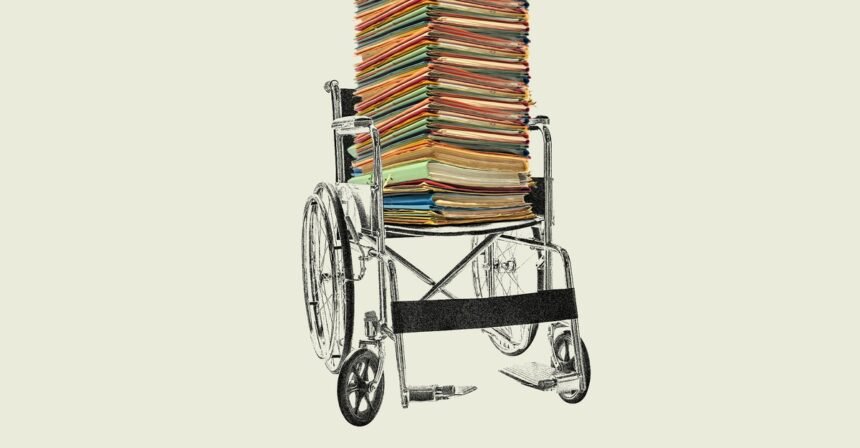The bus smashed into him last month, when he was crossing the street with his wheelchair. By the time he made it to the public hospital in California where I work as a doctor, two quarts of blood had hemorrhaged into one of his thighs, where a tender football-shaped bulge distorted the skin. He remembered his view of the windshield as the bus bore down, then, as he toppled, of the vehicle’s dirty underbelly. He was convinced he’d die.
He didn’t. Trauma surgeons and orthopedists consulted on his case. He got CT scans, X-rays, and a blood transfusion. Social workers visited him, as did a nutritionist—he was underweight. Antibiotics mopped up the pneumonia he’d contracted from inhaling saliva when he’d passed out. He remained hospitalized for more than a week.
This patient, fortunately, had Medicaid, which meant not only that his care was covered but also that he could see a primary-care doctor after discharge. The public hospital where I’m an internist would have treated him comprehensively regardless of his ability to pay. But in many places, uninsured patients might receive only emergency stabilization at the hospital, face bankrupting bills, and, unless they can pay out of pocket, be denied care at outpatient clinics. And because of work requirements that Congress just passed to restrict Medicaid, the number of uninsured people will quickly grow in the coming months and years.
On the face of it, the requirement that Medicaid beneficiaries submit proof of employment shouldn’t worry people like my patient. Over the course of his life, scoliosis has curved his spine so much that his shoulders hover a couple of feet in front of his legs when he stands, and he’s relied on a wheelchair for more than a decade. His medical condition should exempt him.
But he told our team that he lives in shelters, so he lacks a fixed address. He doesn’t have a cellphone. He could access government websites at a public library, except that his request for a power wheelchair, which Medicaid will cover, hasn’t been approved yet, and navigating the city in a standard one exhausts him. Plus, every time he leaves his stuff behind at the shelter to go somewhere, he told me, it’s stolen. At present, he doesn’t even own an official ID card.
As a doctor in a hospital that serves the urban poor, I see patients who already face such a gantlet of obstacles that modest barriers to accessing government programs can effectively screen them out. The White House’s stated aim with the changes is to reduce waste, fraud, and abuse. But according to projections from the nonpartisan Congressional Budget Office, nearly 12 million Americans will lose insurance by 2034 because of the impacts of the new legislation on Medicaid enrollment and restrictions on Affordable Care Act marketplaces. The safety-net institutions that serve many of the country’s poorest residents cannot make up for the gap. Some hospitals will undoubtedly face financial disaster and close, especially in rural areas—leaving patients with even less ability to get treatment.
Here’s a representative sample of patients on Medicaid I’ve treated recently: a father bleeding into his brain who speaks a Chinese-minority dialect that required multiple conversations with interpreters to identify. A middle-aged man with type 1 diabetes who suffered a stroke that resulted in such severe memory deficits that he can’t reliably remember to inject insulin. A day laborer with liver inflammation who works long hours in construction, often seven days a week, and who’s paid in cash. A young woman with a fentanyl addiction who was too weak and exhausted from malnourishment to enroll in a drug-rehabilitation program. A patient with a dog bite and a skin infection who has ricocheted between low-wage restaurant jobs.
Some of my patients are employed, as are more than two-thirds of adult Medicaid beneficiaries under age 65 without a disability. Others aren’t—and within that group, every one of them would meet criteria for exemption from work requirements, among them medical inability to work, pregnancy, caretaking duties, enrollment in a substance-use treatment program, or at least half-time-student status.
But whether because of language barriers, physical or cognitive disability, lack of internet or phone, or job instability, for all of these patients, overcoming additional bureaucratic barriers would be burdensome at best. For many of them, it would be nearly impossible.
There’s little reason to doubt that, with work requirements in place, many patients like mine will be removed from Medicaid even though they should qualify. After Arkansas deployed work requirements for Medicaid in 2018, for instance, more than two-thirds of the roughly 18,000 people who were disenrolled still should have qualified, according to one estimate. What The Atlantic’s Annie Lowery has called the time tax—“a levy of paperwork, aggravation, and mental effort imposed on citizens in exchange for benefits that putatively exist to help them”—falls disproportionately on those least likely to possess the connections, education, or resources to cut through an endless slog of canned hold music, pages that fail to load, and automated mazes of bureaucracy that dead-end before the caller can connect to a human.
The time tax of proving employment will act as a gatekeeping device, excluding people from Medicaid while foisting the blame onto their shoulders. It is, in effect, engineered to save money with systems onerous enough to disenfranchise people from what they’re entitled to. The bill will slash approximately $1 trillion from Medicaid by 2034, $325 billion of that because of work requirements, according to the latest Congressional Budget Office cost estimates. It will also waste a colossal amount of money creating the mechanisms to deny people care: Though Congress has allocated only $200 million in federal funding for implementing work requirements, the true cost of setting up and administering these systems will likely be many times more, perhaps as much as $4.9 billion, based on one estimate that drew from states that have tried to put in place such requirements.
These cuts will play out differently in each state, and even within states. They’ll gut rural health care in some locales, hurt dense urban neighborhoods in others, and hit the working poor everywhere. Their effects will be modulated by how cumbersome or efficient work-verification systems are, by the availability of insurance-eligibility workers, and by community outreach or lack thereof. But in every state, patients will suffer. That’s the predictable consequence of legislation that saves money by letting Americans get sick.







